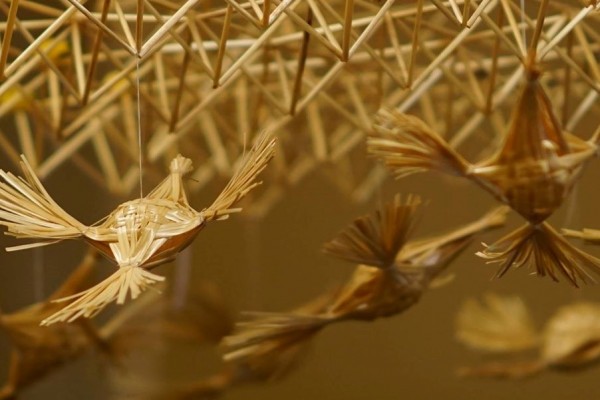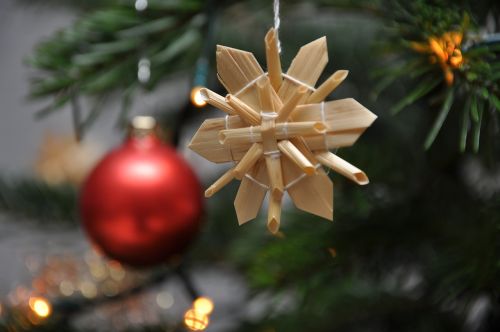
Dancing was not allowed during Advent, however ethnologists tell us that Dzūkai (from Dzūkija region in southeastern Lithuania) would gather not to dance but to walk in rhythmic circles, singing more quiet folk songs. Advent songs were different from Christmas songs, with specific refrains, esp. using the words aleliuma, leliumoj. Advent was a time for children‘s games.
 Ethnologist Libertas Klimka reminds us that since ancient Christian times, pre-dawn Sunday Masses dedicated to the Virgin Mary were held during Advent, called “rarotų Mišios” (rarotos, rarotai). The name for these Masses comes from the Latin words at the beginning of the service, Rorate caeli desuper (translated as Drop down dew, ye heavens, from above, and let the clouds rain down the Just one. – Is 45, 8). Mary is symbolized by the morning star, which heralds the arrival of the sun, the Just one, Jesus. During these Advent Masses, an extra candle is lit in honour of the Virgin Mary.
Ethnologist Libertas Klimka reminds us that since ancient Christian times, pre-dawn Sunday Masses dedicated to the Virgin Mary were held during Advent, called “rarotų Mišios” (rarotos, rarotai). The name for these Masses comes from the Latin words at the beginning of the service, Rorate caeli desuper (translated as Drop down dew, ye heavens, from above, and let the clouds rain down the Just one. – Is 45, 8). Mary is symbolized by the morning star, which heralds the arrival of the sun, the Just one, Jesus. During these Advent Masses, an extra candle is lit in honour of the Virgin Mary.
Lithuanians were faithful church-goers, but superstition was rife among country folk. On their way to the early Mass, various sightings could portend good fortune. A good sign was seeing a dog or a wolf. It was particularly important for future brides to attend Advent “rarotai”… If they met a woman on their way to church, their married life would be successful, but if they met a man, they would not be as lucky. Highly important at this Mass was the lighting of candles. Social unity was shown by landowners and peasants lighting them together.
Before adopting the tradition of decorating a Christmas tree in the home, Lithuanians would decorate their houses with straw ornaments called “sodai” above the dining table, made to look like birds and fir branches. When Christmas trees were first introduced, they were hung upside down from the rafters. They would be decorated with candies, and by January 6 (the Feast of the Three Kings), only the wrappers remained. In older times, people mostly exchanged gifts of food at Christmas.
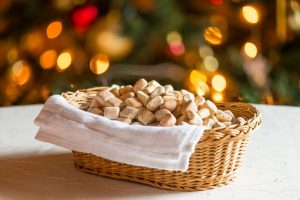
In northern Lithuania, Christmas markets were open every Sunday in Advent. The first market to open was called the ferret market: in early December peasants would trap ferrets (šeškai) and martens to make collars to sell at the “šeškaturgis“. Everything sold at this first market was for keeping warn through the winter. The second market was for selling silk scarves, jewellery and cosmetics (skaistaturgis, for beauty), and the third, saldataurgis , or sweet market, had everything needed for the Christmas table, including sugar, cranberries and poppy seeds.
Advent was a time of mysticism awaiting the Redeemer, but peasants also indulged in superstitions foretelling the future, mostly regarding young women and their marriages, and for farmers hoping for good weather and crops. On St. Barbara‘s feast day on December 4, girls would eat their fill of salty food, hoping to dream about a future husband and his features, a young man who would bring them water to drink. December 13th, St. Lucy‘s feast day was the beginning of 12 days of weather predictions for the next 12 months. Other superstitious behaviour included placing 12 small piles of salt on the doorstep and watching to see which became the wettest, and thus which month would bring the most rain… Sunny weather on December 8 promised a good cabbage crop, a cold Advent meant a hot summer with severe thunder, while a wet December foretold a bad rye crop.
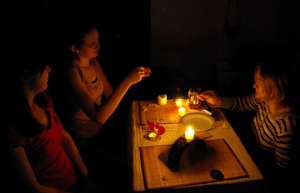 City folk were apt to use candle wax dripped into a clay bowl of water to see what kind of symbol it formed. A ring would mean a wedding, and so on. Questions could be answered by taking a twig from (omeone else‘s) cherry tree on St. Andrew‘s Day, November 30, bringing it home and with the question in mind, putting it in water. If it blossomed by Christmas Eve, the answer to the person‘s question was yes…
City folk were apt to use candle wax dripped into a clay bowl of water to see what kind of symbol it formed. A ring would mean a wedding, and so on. Questions could be answered by taking a twig from (omeone else‘s) cherry tree on St. Andrew‘s Day, November 30, bringing it home and with the question in mind, putting it in water. If it blossomed by Christmas Eve, the answer to the person‘s question was yes…
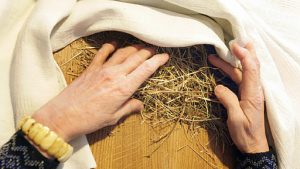 More religious in intent was placing straw under the white Christmas Eve tablecloth as a symbol of the manger, yet supersition persists to this day involving the straw. Family members wouldeach pull a straw from under the cloth, and interpret its length according to their desires. A short one may mean a short life, or an imminent graduation or job change. The end of the straw might have seeds attached, which means a successful year, and a branched piece may mean the parting of ways.
More religious in intent was placing straw under the white Christmas Eve tablecloth as a symbol of the manger, yet supersition persists to this day involving the straw. Family members wouldeach pull a straw from under the cloth, and interpret its length according to their desires. A short one may mean a short life, or an imminent graduation or job change. The end of the straw might have seeds attached, which means a successful year, and a branched piece may mean the parting of ways.
Long, dark December evenings were a time of contemplation and prayer, quiet work and preparation for the joy of Christmas.
With information from bernardinai.lt, alkas.lt
